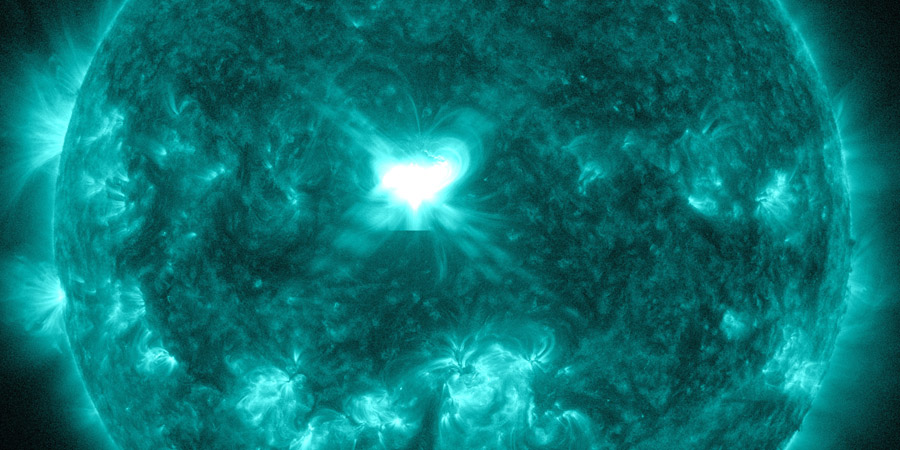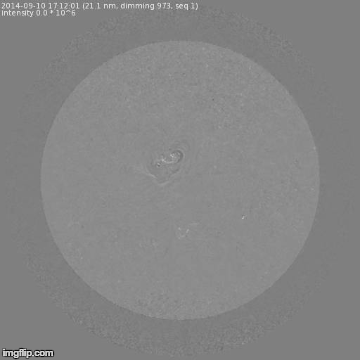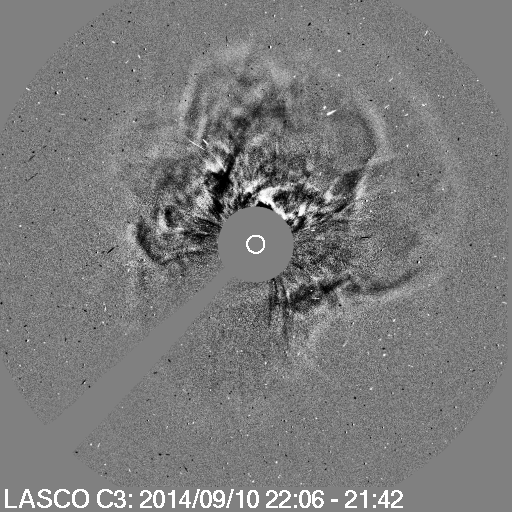X1.6 solar flare from sunspot region 2158
Wednesday, 10 September 2014 17:50 UTC

We had to wait almost 3 months for another X-class solar flare but sunspot region 2158 did it! It was the source of a long duration X1.66 (R3-strong radio blackout) solar flare that peaked today at 17:45 UTC.
We knew this sunspot region was capable of producing a strong solar flare as it was this region which was the source of a major far side solar flare back on September 1. However, this solar flare still came a bit as a surprise as this region showed magnetic seperation and lost it's delta classification. Sunspot region 2158 is currenty directly facing Earth and this solar flare is likely to launch a Coronal Mass Ejection considering the long duration of the flare and the coronal dimming which can already be seen on imagery from NASA SDO. GOES-15 XRS graph.
Coronal dimming
Coronal dimming and a massive large scale coronal propagating front can currently be seen on SDO footage, all signs that a CME has been launched.

A Type II Radio Emmision was observed with a velocity of 3750km/s. This indicates that there was a shockwave racing trough the Sun's corona at a speed of 3750km/s. This is very fast and a major CME is very likely. We are waiting for coronagraph imagery to see how large this CME is but a major CME is very much on the cards.
Video credit: Nariako Nitta (LMSAL) and SDO.
Solar Radiation Storm
We also issue a warning for a possible Solar Radiation Storm. The ammount of high energy protons near Earth are already elevated and we could cross the S1 threshold with this latest eruption.
NOAA SWPC alerts
ALERT: Type II Radio Emission Begin Time: 2014 Sep 10 1727 UTC Estimated Velocity: 3750 km/s
ALERT: Type IV Radio Emission Begin Time: 2014 Sep 10 1728 UTC
SUMMARY: X-ray Event exceeded X1 Begin Time: 2014 Sep 10 1721 UTC Maximum Time: 2014 Sep 10 1745 UTC End Time: 2014 Sep 10 1820 UTC X-ray Class: X1.6 Optical Class: 2b Location: N15E09 NOAA Scale: R3 - Strong
SUMMARY: 10cm Radio Burst Begin Time: 2014 Sep 10 1723 UTC Maximum Time: 2014 Sep 10 1732 UTC End Time: 2014 Sep 10 1826 UTC Duration: 57 minutes Peak Flux: 1300 sfu Latest Penticton Noon Flux: 159 sfu
WARNING: Proton 10MeV Integral Flux above 10pfu expected Valid From: 2014 Sep 10 2115 UTC Valid To: 2014 Sep 11 2100 UTC Warning Condition: Onset Predicted NOAA Scale: S1 - Minor
Coronal Mass Ejection *update 22:20 UTC*
Coronagraph imagery from SOHO/LASCO are now slowly coming in and they indeed show a halo CME that is coming towards Earth. The CME is an asymmetrical full halo CME with the bulk heading north but a very respectable portion of the magnetic cloud is coming towards Earth. There are not yet enough frames available to give an accurate speed estimate but the CME looked to have travelled an impressive distance already in just 5 hours which suggests this CME is indeed fast.
For a more detailed analysis we will however need more imagery. More information will be posted tomorrow regarding this CME and we will estimate when this CME could arrive at Earth. We will also put out a forecase as to what kind of geomagnetic activity we can exactly expect but it already looks possible that middle lattitude locations might have a chance for aurora when the CME arrives.

Thank you for reading this article! Did you have any trouble with the technical terms used in this article? Our help section is the place to be where you can find in-depth articles, a FAQ and a list with common abbreviations. Still puzzled? Just post on our forum where we will help you the best we can!
Latest news
Latest forum messages
More topicsSupport SpaceWeatherLive.com!
A lot of people come to SpaceWeatherLive to follow the Sun's activity or if there is aurora to be seen, but with more traffic comes higher server costs. Consider a donation if you enjoy SpaceWeatherLive so we can keep the website online!

Space weather facts
| Last X-flare | 2024/12/08 | X2.2 |
| Last M-flare | 2024/12/26 | M3.0 |
| Last geomagnetic storm | 2024/12/17 | Kp5+ (G1) |
| Spotless days | |
|---|---|
| Last spotless day | 2022/06/08 |
| Monthly mean Sunspot Number | |
|---|---|
| November 2024 | 152.5 -13.9 |
| December 2024 | 115.2 -37.3 |
| Last 30 days | 118.5 -39.1 |


